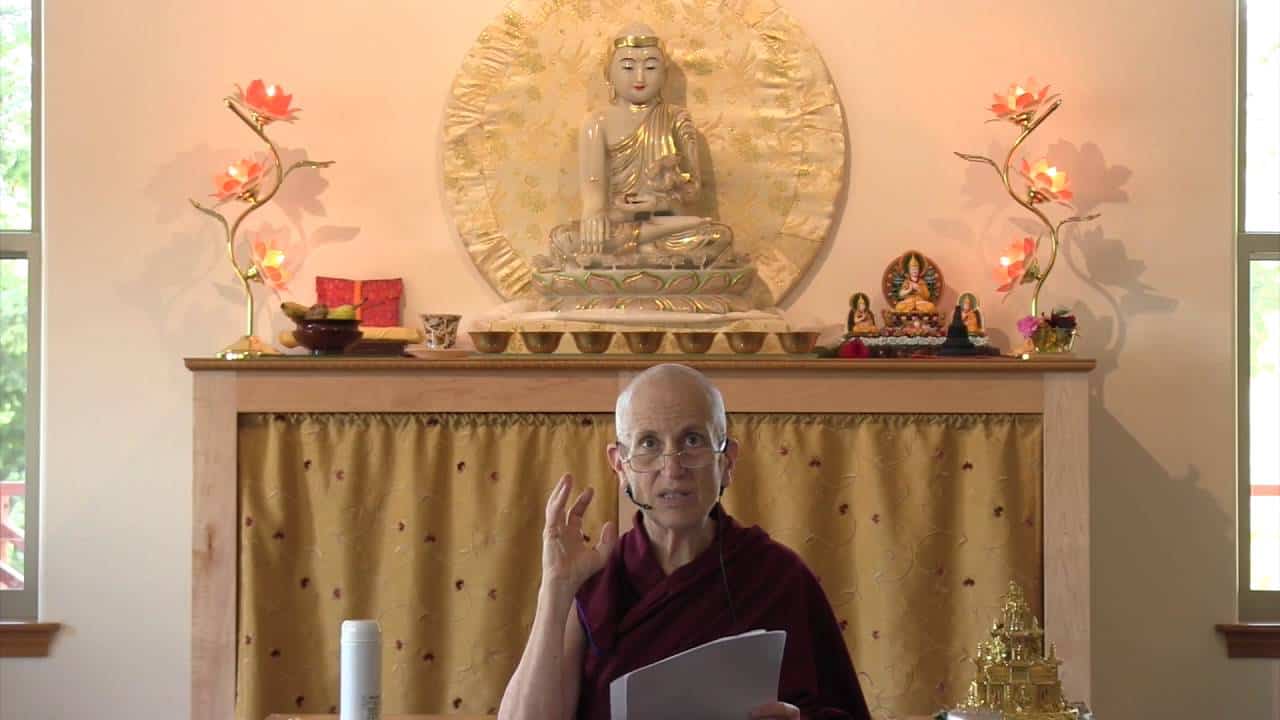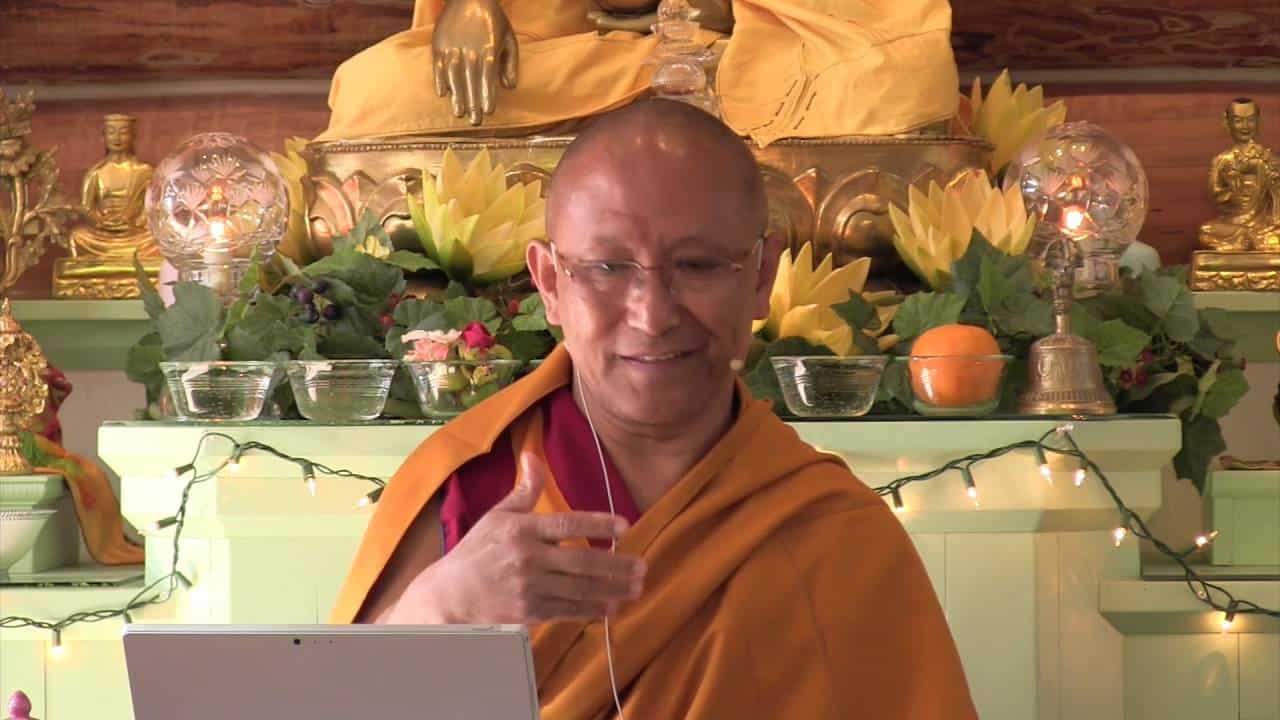Chandrakirti’s homage to great compassion
Chandrakirti’s homage to great compassion
The text turns to training the mind on the stages of the path of advanced level practitioners. Part of a series of teachings on the Gomchen Lamrim by Gomchen Ngawang Drakpa. Visit Gomchen Lamrim Study Guide for a full list of contemplation points for the series.
- How compassion is the root of the path of the universal vehicle
- Chandrakirti’s homage to great compassion
- The three factors that are the causes for bodhisattvas
- The function of compassion at the beginning, middle, and end of the path
- Compassion observing sentient beings—six analogies comparing sentient beings to a waterwheel
Gomchen lamrim 57: Homage to great compassion (download)
Contemplation points
This week, we started studying the stages of the path for the advanced practitioner (those going for full awakening). It is compassion that has us practicing at this level of the lamrim, that has us going for full awakening. We are no longer working for our own liberation but seek to be a Buddha so that we can be of great benefit to ALL beings.
With this in mind, contemplate the following points from the teaching:
- At the beginning of the text, it says that bodhicitta “is the source of all goodness.” Why is it that everything that is good in the universe comes about through bodhicitta? Spend some time really considering how every happiness you have and will experience can be traced back to bodhicitta.
- “By working for others’ welfare, you achieve your own naturally.” Why is it that working for our own pleasures causes us so much suffering? Why is it that when we give up this pursuit of our own pleasure and work for others’ welfare, that our own happiness comes about quite naturally? How have you seen this truth in your own life?
- Venerable Chodron said that it’s important to know the definition of compassion: the wish for others to be free from suffering and the causes of suffering (dukkha). But we have to go further than this. It goes a lot deeper than we think.
- We usually think that suffering is just the ouch kind of mental and physical pain and that the causes of suffering come from others. What does the dharma teach is suffering (the three kinds of dukkha) and what are its true causes?
- Consider each one and how you’ve seen this in your own life and in the lives of others. What are you really wishing others to be free of?
- What does compassionate action mean and how is it different from people-pleasing?
- Consider the three causes for bodhisattvas given by the Homage to Great Compassion: compassionate mind, non dual awareness, and bodhicitta. Let’s look at each:
- Compassionate mind is a form of compassion that cherishes others more than self and cherishes all living beings equally.
- Consider what this means: being willing to go out of our way, do things that might be inconvenient, threaten our reputation or wellbeing… all in the name of benefitting others. How have you seen this kind of compassion in the world. Have you experienced this kind of compassion in your own life?
- Venerable Chodron says we have the ability to develop this kind of compassion and that to whatever extent we can cultivate and practice it, even if in small ways, we make things better for ourselves and all sentient beings. Take some time to consider how even a little bit of compassion can make an incredible difference in the world?
- How have you see your own compassion grow as you’ve practiced the Dharma? What can you do to continue to strengthen the compassionate mind?
- Non dual awareness here is being free of the extremes of absolutism and nihilism. Why does being free from these two extremes become a cause for becoming a bodhisattva?
- The awakening mind/bodhicitta that is the cause for a bodhisattva is fabricated bodhicitta. It is referred to as “bodhicitta like sugar cane bark” in that contrived bodhicitta is like chewing on the bark whereas spontaneous bodhicitta is like tasting the sugar cane itself. Why is it so important to put so much energy into cultivating this form of bodhicitta? How does it lead to becoming a bodhisattva?
- Compassionate mind is a form of compassion that cherishes others more than self and cherishes all living beings equally.
- Consider the three functions of compassion: the seed at the beginning of the path, the water and fertilizer that makes the seed keep growing in the middle of the path, and the ripened fruit that is the harvest of the path. Let’s look at each:
- Compassion as the seed at the beginning of the path:
- How is it that compassion got you started on your own spiritual path?
- How has seeing your own dukkha and the dukkha of others led to feeling a wish to free yourself and others from their suffering?
- How does compassion lead to the GREAT compassion of a bodhisattva, the kind of compassion that has the bodhisattvas “getting their feet wet?”
- Of course it takes time, joyous effort, and habituation to get from our level of compassion (mostly aspiration) to that of a bodhisattva (spontaneous action). What can you do now to to begin to work towards greater and greater levels of active compassion?
- Compassion as the water and fertilizer that makes the seed keep growing in the middle of the path:
- When you’re doing the bodhisattva activities like generosity, ethical conduct, fortitude, joyous effort, concentration and wisdom, it’s bodhicitta that underlies it and keeps us going. How has compassion helped keep you motivated on the path when your practice isn’t going the way you want or when your trying to help someone and it’s not going as you had hoped?
- Compassion as the ripened fruit that is the harvest of the path:
- Compassion as the seed at the beginning of the path:
- Consider the analogies of the water wheel, illustrating that migrating beings have no autonomy in samsara. How does thinking in these ways fuel your renunciation and your compassion?
- Just as the buckets are tied by a strong rope, we are tied to samsara by ignorance, afflictions and karma.
- Just as the pulley moves the water wheel, the afflicted mind propels us into various rebirths where again and again, we find ourselves in difficult situations.
- Just as the water wheel continuously goes up and down, beings wander without end from the highest meditative absorption to the lowest hell realm.
- Just a the bucket goes down easily but only goes up with great effort, it’s easy to have an unfortunate rebirth and takes great effort to attain a higher one.
- Just as the water wheel goes up and down without discerning a beginning or end to the cycle, so beings go through the 12 links of dependent arising.
- Just as the water wheel is battered on a daily basis, hitting the sides of the well on the way up and down, so we are battered by the constant migrations and regardless of our rebirth, we experience great dukkha.
Venerable Thubten Chodron
Venerable Chodron emphasizes the practical application of Buddha’s teachings in our daily lives and is especially skilled at explaining them in ways easily understood and practiced by Westerners. She is well known for her warm, humorous, and lucid teachings. She was ordained as a Buddhist nun in 1977 by Kyabje Ling Rinpoche in Dharamsala, India, and in 1986 she received bhikshuni (full) ordination in Taiwan. Read her full bio.


